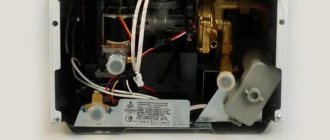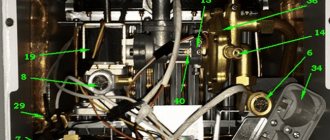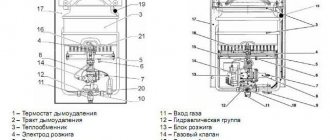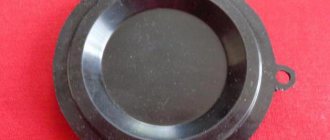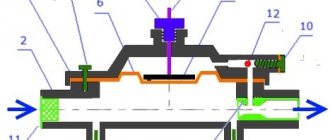Home » Heating and water supply » Gas water heaters » Gas water heater water block - types and adjustment
One of the key elements of an instantaneous water heater is the gas water heater block or “frog”. It is located inside the device in front of the heat exchanger and is responsible for regulating the operation depending on the flow of water into the device.
…
- 1 Types of water blocks and operating principle
- 2 Possible malfunctions of the water block
- 3 How to repair a “frog” with your own hands?
- 4 How to clean the “frog”?
- 5 How to use a water block to make a column more economical?
Types of water blocks and operating principle
The water block of a geyser can be made of different materials:
- brass - an alloy of copper and zinc;
- plastic - practicality and long service life;
- polyamide - long service life is ensured through the use of fiberglass.
The design of the water block of a geyser implies the presence of the following components:
- base and cover with screws;
- diaphragm with a disk mounted on the rod;
- flow regulator;
- nozzles;
- flow regulator;
- temperature selector;
- hot water filter.
The water block is divided into two parts by a rubber membrane, one of which is connected to the cold water supply, and the other is equipped with a rod connected to the gas valve. On the metal rod of automatic devices there are “wings” connected to the electric ignition unit.
The principle of operation of the “frog” is as follows:
…
- when you open a cold water tap, one of the cavities of the block is filled;
- the water pressure puts pressure on the membrane, which in turn bends and puts pressure on the rod located in the second part of the “frog”;
- the rod begins to press on the valve, thereby opening the gas supply;
- in automatic dispensers there are “ears” on the stem that send a signal to the ignition unit;
- a spark is produced that ignites the flame;
- after closing the hot water tap, the internal parts begin to move in reverse, the rod returns to its original position using a spring and closes the gas supply.
The equipment of automatic and semi-automatic geysers may differ slightly, but the operating principle itself remains unchanged.
How a gas water heater reducer works: design
The main task of the gas water heater reducer is to pass water inside the equipment and take care of turning the heater on and off when opening and, accordingly, closing the tap. The unit located in the gearbox is responsible for changing the water flow. The structure of the “frog” is quite complicated.
Thus, the water-gas reducer of a gas water heater consists of:
- Membrane and disc (fungus);
- Flow regulator;
- Temperature regulator;
- Water supply regulator when the mixer is open and closed;
- Venturi nozzle;
- Hot water filter.
The water block also performs a protective function - if the water pressure is insufficient, the reducer will turn off the column, ensuring that the equipment does not overheat
The structure of the unit in each individual model remains unchanged. The only differences can be in the material used to make the unit: the gas-water block is made of brass, plastic, or polyamide.
The operation of the water-gas block of a flow-through heater is based on the principle of the mechanical effect of water flow on its parts.
Thus, water entering the column affects the diaphragm and disk (fungus). The parts change their location, which causes the valve stem to activate the gas unit, and fuel begins to flow to the burner. As soon as the tap closes, the pressure in the system decreases, the parts return to their places and the burner goes out.
Possible malfunctions of the water block
Failure of the water block is a fairly common problem with a geyser. The following malfunctions often occur:
- The membrane has ruptured - its average service life is 7 years. Due to the hardness of the water, the rubber can quickly tear. A sign of a breakthrough is leakage of the gearbox.
- The diaphragm has lost its elasticity - for proper operation it is necessary that the membrane quickly respond to changes in water pressure.
- The gasket has become rigid - this leads to late operation of the column. It will turn on and off with a delay.
- Rod clogging - when the membrane ruptures, water enters the metal rod, which quickly corrodes. As a result, its movement becomes difficult. A sign of a malfunction is that it is difficult to start the column; it starts working only with high water pressure.
- The coarse filter is clogged - if the water is connected incorrectly to the pipes, the mesh located at the inlet to the gearbox may become clogged. A sign of failure is a difference in pressure at the inlet and outlet of the column.
All of the above faults are quite easy to fix if you understand the structure of the speaker. The need to completely replace the water block rarely occurs.
What do you need to know about geyser ventilation?
How does an automatic gas water heater work? —
…
https://oteple.com/kak-rabotaet-avtomaticheskaya-gazovaya-kolonka/
The design and mechanism of operation of the rod of the water unit of the HSV gas column.
Typically, the stem is a steel, stainless or brass rod. On one side it has a cylindrical end or point, on the other side there is a movable, semi-movable or solid plate. All components have original sizes, shapes and diameters. The purpose of all varieties of this spare part is to transmit water pressure and subsequently start the burner to heat the water flowing through the column. Here are the most common rod models:
- VPG-3208, 3212, etc. - steel with a plastic plate
- VPG KGI (Gorky column) - brass with a plastic, brass or fixed aluminum plate.
- VPG Astra - coated steel, brass semi-movable plate.
- VPG Neva 4510, 4511, 4513 - steel with chrome coating and reinforced plastic plate.
For dispensers with electronic control using German technology with a horizontal water-gas unit: Vector 20W/E, Vector-Star, Oasis, Volna, Aquilon, Neva-Transit, Rossiyanka, Vector-Lux Eco, MasterGaz and others. As a rule, a stainless steel rod D 2,3,4,5 mm, on which a movable sleeve for switching on the flow sensor (microswitch) is mounted. On the inside there is a fitting-nut D 12,14,16 mm, into which the sealing gland is pressed. It prevents water from passing from the cavity of the water unit and hitting the microswitch. On the outer part of the movable bushing there is a return spring with guides and a sealing seal against gas escaping into the internodal space. The material from which the rod is made and its chrome coating are equally important. This directly affects durability, because... the inside of the rod on the side of the water unit is exposed to chlorine water and salts. A violation in the coating leads to cutting through the oil seal and failure of the seal. This manifests itself in failure to turn on and off the column and failure of the electronic unit.
Thus, the operating mechanism can be traced not only in pressure transmission, but also in the start of electronic ignition, as well as in the mechanism for opening automatic safety valves.
Rods are also divided by type of installation. There are: horizontal, vertical, combined installation. During operation, it is important to ensure timely maintenance, repair, adjustment and monitoring of the operation of geysers. Minor deviations in operation trigger the mechanism of “oxidation”, corrosion and failure of individual components of water units, microswitches and sensors. Manufacturers of gas water heaters assign the responsibility for monitoring the operation of the water heater to the consumer during operation. During initial installation, the service organization or gas service workers must explain to the consumer the conditions for normal operation of the water heater.
How to repair a “frog” with your own hands?
Hard water, exposure to high temperatures and other factors gradually cause the elements of the water block to wear out. If any damage is detected, it is necessary to urgently repair the problematic part.
If desired, you can repair the water block of a geyser yourself, since its design is quite simple. Before doing this, it is important not to forget to turn off the fuel and water supplies.
If you need to adjust the pressure of the device, you need to twist the special bolts located on the back of the block. Then the water is drained from the heat exchanger; for this purpose, a tap located below the water heater is used. Disconnect the gas and water supply pipelines. Now the “frog” can be removed. The design of the water block may vary slightly depending on the model. In order for the removal of the water unit to be successful, all pipes and wires should be disconnected from it.
Useful tips to ensure long and reliable operation of geysers
- Installation and connection must be carried out by qualified specialists. Often the quality of its operation depends on how the gas water heater is configured.
- It is necessary to regularly clean the igniter and heat exchanger from combustion products (it is strange to blame the column for blockages). This will significantly extend the “lifespan” of the device.
- In old houses with too low water pressure in the system, it is better to install special pumps. With stable water pressure, automatic start-up occurs without problems, and the heating temperature will be maintained more correctly.
- Important recommendations from the manufacturer as stated in the user manual must be followed.
Excellent performance at average consumption. High heating rate. The automation works excellently: the speaker turns itself on and off without delays or false alarms. Starts working even with the slightest trickle of water.
The speaker is volatile; it will not work without a constant connection to the power supply. Use in areas with water supply problems will be extremely inconvenient. Another nuance is that as the pressure drops, the water temperature rises.
A little noisy, but over time you can get used to it. Quite demanding, she needs careful care. Once every one and a half to two years, it is necessary to clean the channels from scale so that the column continues to function properly. This way the user will protect himself from fire or explosion.
Ariston FAST CF 11P
Quite an economical column with high efficiency. It consumes little gas and produces consistently hot water. Works well with low pressure, low pressure. The company has done a good job on user safety, using several technologies for protection. If there is no fire, the gas supply stops. The heater operates on both natural and liquefied gas. The instantaneous gas water heater without a chimney is designed in such a way as to minimize heat loss, increasing the efficiency of heating water. Despite the truly excellent, stable performance, there is a big fly in the ointment that the manufacturer slips in. You cannot find replacement parts from Ariston, and there are no replacement parts. When an element fails, you have to search for a long time for a technician who understands a specific mechanism, along with consumables.
Ariston Marco Polo Gi7S
The gas instantaneous water heater without a chimney Ariston Marco Polo Gi7S is in the most popular price segment. This is where most people look for a solution for their home. The model turned out to be surprisingly successful: low noise level, good response even to a thin stream of water.
In terms of price-quality ratio, this heater occupies one of the leading positions. The model has introduced excellent trends of recent years: touch control, power adjustment, temperature control. The protection and safety system is at a high level, including an electronic anti-freeze system.
Operates on liquefied or natural gas, delivering the same efficiency.
| type of instalation | Wall |
| Installation method | Vertical |
| Combustion chamber type | Closed |
| Ignition type | |
| Power | |
| Gas consumption | Natural 2.2 m 3 /h Liquefied 0.79 m 3 /h |
| Performance | |
| Peculiarities | Anti-blowing valve Autodiagnosis |
| Rating (0-5) |
Ariston is a company that has something to offer even the most demanding client. The range includes ultra-budget gas instantaneous water heaters without a chimney, expensive and premium ones. They differ in design and technology used. The numbers and characteristics may be similar, but in everyday use, underground problems appear, such as unstable operation. Ariston Marco Polo M2 is the most common model that is in demand among users. It has a low cost, and at the same time shows good performance. For its price it is a good model, although it is not without its shortcomings. Gas water heaters without a closed chimney are a separate type of device, and the manufacturer has excellent examples in this class. Ariston Marco Polo Gi7S has an average cost and high efficiency, thanks to which it has gained popularity. This water heater definitely takes the lead in the TOP. Second place - Ariston Marco Polo M2. Ariston FAST CF 11P receives honorary bronze due to problems with replacement parts; reviews of the column are not the most positive.
How to clean the frog?
The unit should be cleaned every year. After removing the cover or disassembling the gearbox into two parts, the inside of the unit is cleaned and the elements are maintained. The process of cleaning the unit removes scale and solid particles that have settled at the bottom of the unit. You should also clean the mesh on the inlet pipe. It is recommended to lubricate the rod with castor oil or grease. The gasket also needs to be lubricated if it feels like it has lost its elasticity.
Caring for the elements of the water block will extend the service life of the gas water heater and reduce the likelihood of any malfunctions.
During each cleaning, the functionality of the components is checked and, if necessary, they are replaced:
- replacement of the stem seal is usually required approximately every 3 years to protect the gas valve from moisture;
- the membrane should be changed when microcracks appear or ruptures occur.
Worn parts need to be replaced with new branded products. The membrane can be purchased separately, however, if desired, you can also find a kit that includes all the components for replacement.
How to use a water block to make a column more economical?
Using the settings of the water unit, you can make the geyser more economical. To do this, optimize fuel consumption and outlet water pressure. The water gear is adjusted using bolts located on the back of the block. To increase the pressure of hot water, the bolts need to be loosened slightly.
It is not advisable to adjust the water block yourself unless absolutely necessary. It is better to call service center specialists - they will make adjustments with high accuracy and check the components for functionality.
